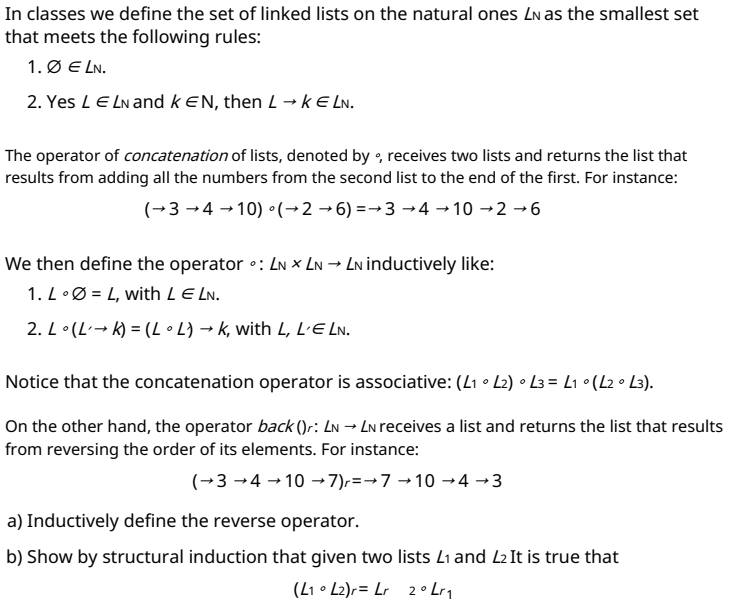On the other hand, the operator back ()r: Zn → Ln receives a list and returns the list that results rom reversing the order of its elements. For instance: (→3 →4 → 10 →7)r=→7 →10 →4 →3 a) Inductively define the reverse operator. b) Show by structural induction that given two lists 41 and L2 It is true that (L1 • L2)r= Lr 2 º Lr1
On the other hand, the operator back ()r: Zn → Ln receives a list and returns the list that results rom reversing the order of its elements. For instance: (→3 →4 → 10 →7)r=→7 →10 →4 →3 a) Inductively define the reverse operator. b) Show by structural induction that given two lists 41 and L2 It is true that (L1 • L2)r= Lr 2 º Lr1
C++ Programming: From Problem Analysis to Program Design
8th Edition
ISBN:9781337102087
Author:D. S. Malik
Publisher:D. S. Malik
Chapter17: Linked Lists
Section: Chapter Questions
Problem 9PE
Related questions
Question

Transcribed Image Text:In classes we define the set of linked lists on the natural ones LN as the smallest set
that meets the following rules:
1. Ø E LN.
2. Yes LE LN and kEN, then L→ k E LN.
The operator of concatenation of lists, denoted by , receives two lists and returns the list that
results from adding all the numbers from the second list to the end of the first. For instance:
(→3 →4 → 10) °(→2 →6) =→3 →4 →10 →2 →6
We then define the operator •: Ln × LN → Ln inductively like:
1. L•Ø = L, with LE LN.
2. L•(L-→ k) = (L • L} → k, with L, L'E Ln.
Notice that the concatenation operator is associative: (L1 • L2) • L3 = L1 •(L2 • L3).
On the other hand, the operator back ()r: Ln → Ln receives a list and returns the list that results
from reversing the order of its elements. For instance:
(→3 →4 → 10 →7),=→7 →10 →4 →3
a) Inductively define the reverse operator.
b) Show by structural induction that given two lists L1 and L2 It is true that
(L1 • L2)r= Lr 2 ° Lr1
Expert Solution
This question has been solved!
Explore an expertly crafted, step-by-step solution for a thorough understanding of key concepts.
Step by step
Solved in 2 steps with 1 images

Recommended textbooks for you

C++ Programming: From Problem Analysis to Program…
Computer Science
ISBN:
9781337102087
Author:
D. S. Malik
Publisher:
Cengage Learning

C++ Programming: From Problem Analysis to Program…
Computer Science
ISBN:
9781337102087
Author:
D. S. Malik
Publisher:
Cengage Learning